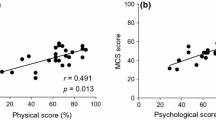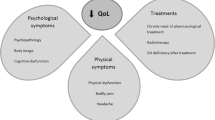Abstract
Quality of life (QoL) may be affected in acromegalic patients, although the role of disease activity is still unsettled. The aim of the study was to assess the QoL of acromegalic patients with a specific questionnaire (ACROQOL). ACROQOL was evaluated in a prospective study (at baseline, at 6 and 24 months) in 23 active untreated acromegalic patients. Control of acromegaly was defined by normal age-matched serum IGF-I concentrations. Patient groups were defined as controlled or uncontrolled at 6 months and at 24 months: controlled or uncontrolled during the entire study period (ACROCC or ACRONC, respectively) or uncontrolled at 6 months and controlled thereafter (ACROC). At 6 months, ACROQOL scores improved globally (from 54.3±21 to 65.1±19, p=0.04) as did subdomains and were inversely related to IGF-I variation (r=−0.50, p=0.052). At 24 months, ACROQOL improved globally (from 54.3±21 to 65.7±18.0, p=0.04) and this was also seen in the appearance subdomains; however, no correlation was revealed between variation of serum IGF-I concentrations and changes in ACROQOL total score (r=0.008, p=0.87). ACROQOL scores did not significantly change in ACRONC (p=0.310) and in ACROC (p=0.583), whereas it improved globally (from 42.1±22.1 to 58.8±16.04, p=0.021) and in psychological subdomains in ACROCC; however, it reflected the improvement occurred within the first 6 months of disease control. In conclusion, successful treatment, which normalizes disease activity, improves QoL in acromegaly in the short term. However, the lack of correlation between the ACROQOL score in the long term might suggest that factors other than serum IGF-I participate in the well-being of acromegalic patients; however, due to the small sample size, our results need to be confirmed in larger studies.
Similar content being viewed by others
References
Melmed S. Medical progress: Acromegaly. N Engl J Med 2006, 355: 2558–73.
Dekkers OM, Biermasz NR, Pereira AM, Romijn JA, Vandenbroucke JP. Mortality in acromegaly: a metaanalysis. J Clin Endocrinol Metab 2008, 93: 61–7.
Colao A, Ferone D, Marzullo P, Lombardi G. Systemic complications of acromegaly: epidemiology, pathogenesis, and management. Endocr Rev 2004, 25: 102–52.
Orme SM, McNally RJ, Cartwright RA, Belchetz PE. Mortality and cancer incidence in acromegaly: a retrospective cohort study. United Kingdom Acromegaly Study Group. J Clin Endocrinol Metab 1998, 83: 2730–4.
Webb SM, Prieto L, Badia X, et al. Acromegaly Quality of Life Questionnaire (ACROQOL) a new health-related quality of life questionnaire for patients with acromegaly: development and psychometric properties. Clin Endocrinol (Oxf) 2002, 57: 251–8.
Bates AS, Van’t Hoff W, Jones JM, Clayton RN. An audit of outcome of treatment in acromegaly. Q J Med 1993, 86: 293–9.
Biermasz NR, van Thiel SW, Pereira AM, et al. Decreased quality of life in patients with acromegaly despite long-term cure of growth hormone excess. J Clin Endocrinol and Metab 2004, 89: 5369–76.
Biermasz NR, Pereira AM, Smit JW, Romijn JA, Roelfsema F. Morbidity after long-term remission for acromegaly: persisting joint-related complaints cause reduced quality of life. J Clin Endocrinol Metab 2005, 90: 2731–9.
Kauppinen-Makelin R, Sane T, Sintonen H et al. Finnish Acromegaly Study Group. Quality of life in treated patients with acromegaly. J Clin Endocrinol Metab 2006, 91: 3891–6.
Rowles S, Prieto L, Badia X, Shalet SM, Webb SM, Trainer PJ. Quality of life (QOL) in patients with acromegaly is severly impaired: use of a novel measure of QOL: acromegaly quality of life questionnaire. J Clin Endocrinol Metab 2005, 90: 3337–41.
Paisley AN, Rowles SV, Roberts ME, et al. Treatment of acromegaly improves quality of life, measured by AcroQol. Clin Endocrinol (Oxf) 2007, 67: 358–62.
Colao A, Martino E, Cappabianca P et al. First-line therapy of acromegaly: a statement of the A.L.I.C.E. (Acromegaly primary medical treatment Learning and Improvement with Continuous Medical Education) Study Group. J Endocrinol Invest 2006, 29: 1017–20.
Gola M, Bonadonna S, Mazziotti G, Amato G, Giustina A. Resistance to somatostatin analogs in acromegaly: An evolving concept? J Endocrinol Invest 2006, 29: 86–93.
Colao A, Arnaldi G, Beck-Peccoz P, et al. Pegvisomant in acromegaly: why, when, how. J Endocrinol Invest 2007, 30: 693–9.
Giustina A, Mancini T, Boscani PF, et al. Assessment of the awareness and management of cardiovascular complications of acromegaly in Italy. The COM.E.T.A. (COMorbidities Evaluation and Treatment in Acromegaly) Study. J Endocrinol Invest 2008, 31: 731–8.
Glantz SA. Primer of Biostatistics. New York: McGraw-Hill, 2002.
StatXact 4, version 4.0.1. Cytel Software Corporation, Cambridge, MA, USA.
Sonino N, Scarpa E, Paoletta A, Fallo F, Boscaro M. Slow-release lanreotide treatment in acromegaly: effects on quality of life. Psychother Psychosom 1999, 68: 165–7.
Gilbert J, Ketchen M, Kane P et al. The treatment of de novo acromegalic patients with octreotide-LAR: efficacy, tolerability and cardiovascular effects. Pituitary 2003, 6: 11–8.
Webb SM, Badia X, Surinach N; Spanish AcroQol Study Group. Validity and clinical applicability of the acromegaly quality of life questionnaire, AcroQol: a 6-month prospective study. Eur J Endocrinol 2006, 155: 269–77.
Hua SC, Yan YH, Chang TC. Associations of remission status and lanreotide treatment with quality of life in patients with treated acromegaly. Eur J Endocrinol 2006, 155: 831–7.
Woodhouse LJ, Mukherjee A, Shalet SM, Ezzat S. The influence of growth hormone status on physical impairments, functional limitations, and health-related quality of life in adults. Endocr Rev 2006, 27: 287–317.
Aberg ND, Brywe KG, Isgaard J. Aspects of growth hormone and insulin-like growth factor-I related to neuroprotection, regeneration and functional plasticity in the adult brain. ScientificWorld-Journal 2006, 6: 53–80.
Matta M, Couture E, Cazals L, Vezzosi D, Bennet A, Caron P. Impaired quality of life of ppatients with acromegaly: control of GH/IGF-I excess improves psychological subscale appearance. Eur J Endocrinol 2008, 158: 305–10.
Author information
Authors and Affiliations
Corresponding author
Rights and permissions
About this article
Cite this article
Sardella, C., Lombardi, M., Rossi, G. et al. Short- and long-term changes of quality of life in patients with acromegaly: Results from a prospective study. J Endocrinol Invest 33, 20–25 (2010). https://doi.org/10.1007/BF03346555
Accepted:
Published:
Issue Date:
DOI: https://doi.org/10.1007/BF03346555




